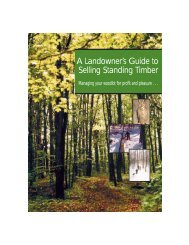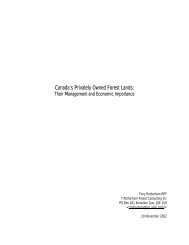A land manager's guide to conserving habitat for forest birds in ...
A land manager's guide to conserving habitat for forest birds in ...
A land manager's guide to conserving habitat for forest birds in ...
You also want an ePaper? Increase the reach of your titles
YUMPU automatically turns print PDFs into web optimized ePapers that Google loves.
Silvicultural system or method<br />
Clearcut<br />
NR<br />
Shelterwood<br />
CR<br />
Risk of exotic<br />
<strong>in</strong>vasion should be low<br />
S<strong>in</strong>gle-tree<br />
selection<br />
R<br />
Group selection<br />
CR—should be used<br />
more <strong>to</strong> perpetuate<br />
<strong>in</strong><strong>to</strong>lerant and<br />
mid-<strong>to</strong>lerant species.<br />
Risk of exotic<br />
<strong>in</strong>vasion should be low<br />
Stand<br />
improvement<br />
R—<strong>in</strong> comb<strong>in</strong>ation<br />
with s<strong>in</strong>gle-tree<br />
selection or crop tree<br />
management <strong>in</strong><br />
degraded or<br />
unhealthy stands<br />
Crop tree<br />
R—especially <strong>in</strong> young<br />
even-aged stands<br />
NR<br />
R—most commonly<br />
recommended <strong>to</strong><br />
develop even-aged, high<br />
composition of oak<br />
—needs follow-up<br />
CR—does not<br />
ma<strong>in</strong>ta<strong>in</strong> growth of<br />
mid-<strong>to</strong>lerant seedl<strong>in</strong>gs<br />
R—develop patches of<br />
oak regenerationcont<strong>in</strong>uously<br />
ma<strong>in</strong>ta<strong>in</strong>s high <strong>for</strong>est<br />
canopy—needs followup<br />
R—<strong>in</strong> comb<strong>in</strong>ation with<br />
shelterwood, group<br />
selection or crop tree<br />
management <strong>in</strong><br />
degraded or<br />
unhealthy stands<br />
R—especially <strong>in</strong> young<br />
even-aged stands<br />
CR—provided site<br />
protection,<br />
aesthetics, hydrology,<br />
regeneration,<br />
and tree conservation<br />
by-law concerns have<br />
been addressed<br />
CR—significant<br />
blowdown potential with<br />
shallow-rooted species<br />
CR—if limited<br />
<strong>to</strong>lerant species also<br />
consider us<strong>in</strong>g some<br />
group selection<br />
CR—usually needs<br />
moni<strong>to</strong>r<strong>in</strong>g and<br />
possible follow-up<br />
regeneration or<br />
tend<strong>in</strong>g work<br />
R—<strong>in</strong> comb<strong>in</strong>ation<br />
with any of the other<br />
recommended<br />
approaches<br />
R—especially <strong>in</strong> young<br />
even-aged stands<br />
CR—where<br />
aesthetics, ecological<br />
objectives, and tree<br />
conservation by-laws<br />
permit<br />
R—most commonly<br />
recommended <strong>for</strong><br />
regeneration of<br />
mature white and red<br />
p<strong>in</strong>e stands<br />
CR—where<br />
component of<br />
hardwoods<br />
approaches 50% or more<br />
CR—<strong>for</strong> establish<strong>in</strong>g<br />
or releas<strong>in</strong>g<br />
hardwood or p<strong>in</strong>e<br />
regeneration<br />
CR—except <strong>in</strong><br />
degraded stands<br />
or ones with health<br />
issues<br />
R—especially <strong>in</strong> mixed<br />
stands or younger<br />
plantations<br />
CR—where<br />
aesthetics,<br />
ecological objectives,<br />
and tree<br />
conservation by-laws<br />
permit<br />
CR—<strong>for</strong> small white<br />
cedar stands or us<strong>in</strong>g<br />
red cedar <strong>to</strong> protect<br />
hardwood<br />
regeneration<br />
CR—<strong>for</strong> cont<strong>in</strong>uous<br />
cover us<strong>in</strong>g light<br />
th<strong>in</strong>n<strong>in</strong>g targets<br />
CR—no more than 20%<br />
of stand dur<strong>in</strong>g any<br />
cutt<strong>in</strong>g period<br />
CR—<strong>in</strong> middle-aged (50<br />
<strong>to</strong> 80 years) white cedar<br />
stands —th<strong>in</strong>n<strong>in</strong>g from<br />
below<br />
R—<strong>in</strong> red cedar<br />
CR—<strong>in</strong> white cedar later<br />
years (80+), as lead—up<br />
<strong>to</strong> shelterwood<br />
NR<br />
CR—where aesthetics,<br />
ecological objectives,<br />
and by-laws permit—<br />
especially where native<br />
species become well<br />
established<br />
CR—<strong>in</strong> stands with no<br />
potential <strong>for</strong><br />
development of<br />
mature stems and no<br />
regeneration<br />
R—commonly<br />
recommended as nurse<br />
crop <strong>for</strong><br />
hardwood or conifer<br />
regeneration<br />
CR—<strong>for</strong> mature stands ><br />
24cm dbh*<br />
CR—where<br />
component of<br />
hardwoods<br />
approaches 50% of more<br />
R—gaps of half the<br />
canopy height<br />
CR—<strong>for</strong> establish<strong>in</strong>g<br />
or releas<strong>in</strong>g<br />
hardwood or p<strong>in</strong>e<br />
regeneration<br />
CR—<strong>in</strong> stands up <strong>to</strong><br />
24cm dbh and at least<br />
16m 2 /h BA<br />
R—dur<strong>in</strong>g early<br />
th<strong>in</strong>n<strong>in</strong>gs or anytime<br />
when there is a high<br />
proportion of<br />
unhealthy stems<br />
R—especially <strong>in</strong><br />
polewood stands<br />
R—especially <strong>in</strong> young<br />
plantations or ones with<br />
considerable health or<br />
<strong>for</strong>m issues (i.e., weevil<br />
damage)<br />
Forest Harvest<strong>in</strong>g 47

















